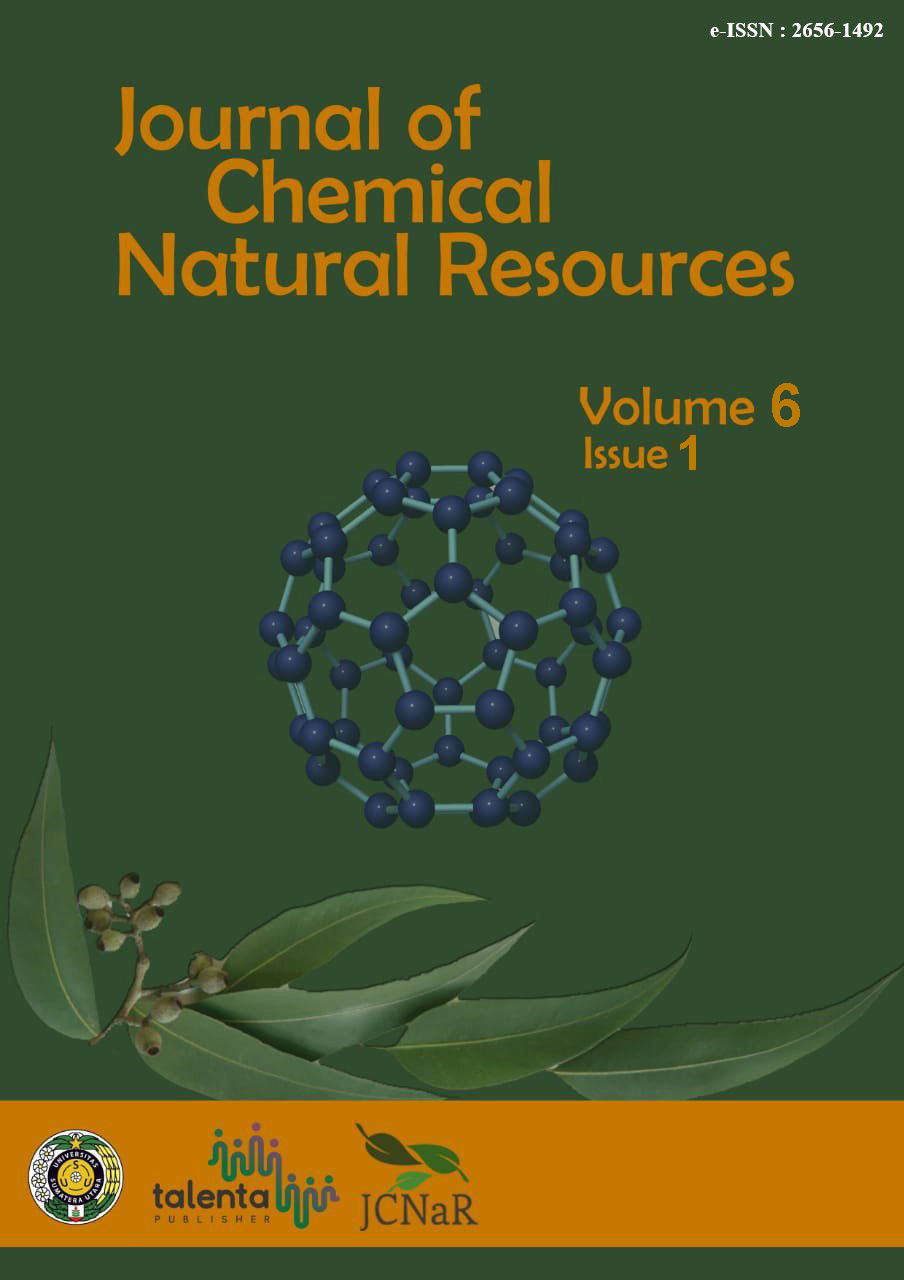Effect of Clay Composition and Human Haircut Waste on Mechanical Properties Mechanical Properties of Epoxy Resin Composites
DOI:
https://doi.org/10.32734/jcnar.v6i1.16220Keywords:
Clay Soil, Hair, MoE, MoR, Water absorptionAbstract
The impact of human haircut waste and the nature of clay soil on the mechanical characteristics of epoxy resin composites has been studied. This study utilizes clay sourced from Wonosari Village, Deli Serdang Regency. The clay was pulverized using a pestle and mortar until it reached a smooth consistency. It is then filtered through a 200 mesh screen and subjected to drying in an oven at a temperature of 105℃ for around 3 h until the water content is completely evaporated. Finally, the dried clay stored in a desiccator. The clay powder was subjected to ball milling for 40 h at 350 rpm. The resulting particle size, determined by particle size analysis (PSA), was found at 0.764 µm. Next, the human haircut waste obtained from the surrounding campus of Universitas Sumatera Utara was prepared by separating the hair from fine hair and washing it clean. Clay soil powder and human hair cut waste are used as fillers, and some variations of epoxy resin mixtures are used. Morphological SEM analysis shows that clay and human haircut waste can be distributed evenly on epoxy resin composites. Testing of water absorption and mechanical properties of the board based on SNI 01-449-2006 standards include the test of dry bending strength (MoR) and the mode of flexural elasticity (MoE) obtained the optimum composition (50: 50: 1: 1) g against the epoxy resin mixture, waste human haircut, and clay soil obtained the water absorption test results of 1.64% with a value of MoE 36789.03 kgf /cm2 and a value of MoR 664,41 kgf/cm2. Test results of mechanical properties and water absorption have fulfilled the SNI 01-449-2006 quality standards for composite boards.
Downloads
References
S. Yuan, S. Li, J. Zhu, and Y. Tang, “Additive manufacturing of polymeric composites from material processing to structural design,†Compos. Part B Eng., vol. 219, no. April, p. 108903, 2021, doi: 10.1016/j.compositesb.2021.108903.
M. Capretti, V. Giammaria, C. Santulli, S. Boria, and G. Del Bianco, “Use of Bio-Epoxies and Their Effect on the Performance of Polymer Composites: A Critical Review,†Polymers (Basel)., vol. 15, no. 24, pp. 1–36, 2023, doi: 10.3390/polym15244733.
R. Dallaev, T. Pisarenko, N. Papež, P. Sadovský, and V. Holcman, “A Brief Overview on Epoxies in Electronics: Properties, Applications, and Modifications,†Polymers (Basel)., vol. 15, no. 19, 2023, doi: 10.3390/polym15193964.
J. Chen, A. J. Kinloch, S. Sprenger, and A. C. Taylor, “The mechanical properties and toughening mechanisms of an epoxy polymer modified with polysiloxane-based core-shell particles,†Polymer (Guildf)., vol. 54, no. 16, pp. 4276–4289, 2013, doi: 10.1016/j.polymer.2013.06.009.
N. B. Othman, “Characterisation and Properties of Bentonite /Polypropylene Composite,†University Sains Malaysia, 2007.
T. Partuti, B. N. H. Kambuna, Y. Dwiyanti, and I. U. Hasanah, “Introducing the manufacture of composites made from natural fillers as craft products for housewives,†J. Community Serv. Sci. Eng., vol. 2, no. 2, p. 56, 2023, doi: 10.36055/jocse.v2i2.21438.
C. F. Cruz, C. Costa, A. C. Gomes, T. Matamá, and A. Cavaco-Paulo, “Human hair and the impact of cosmetic procedures: A review on cleansing and shape-modulating cosmetics,†Cosmetics, vol. 3, no. 3, pp. 1–22, 2016, doi: 10.3390/cosmetics3030026.
S. A. Daulay, F. Wirathama, and Halimatuddahliana, “Pengaruh Ukuran Partikel dan Komposisi Terhadap Sifat Kekuatan Bentur Komposit Epoksi Berpengisi Serat Daun Nanas,†J. Tek. Kim. USU, vol. 3, no. 3, pp. 13–17, 2014.
H. A. Begum, T. R. Tanni, and M. A. Shahid, “Analysis of Water Absorption of Different Natural Fibers,†J. Text. Sci. Technol., vol. 07, no. 04, pp. 152–160, 2021, doi: 10.4236/jtst.2021.74013.
N. Erna Setyaningsih, R. Muttaqin, and I. Mar, “Optimalisasi Waktu Pelapisan Emas-Palladium pada Bahan Komposit Alam untuk Karakterisasi Morfologi dengan Scanning Electron Microscopy (SEM)-Energy Dispersive X-Ray Spectroscopy (EDX),†Phys. Comm, vol. 1, no. 2, pp. 36–40, 2017, [Online]. Available: http://journal.unnes.ac.id/nju/index.php/pc
P. I. Purboputro, “Pengaruh Panjang Serat Terhadap Kekuatan Impak Komposit Enceng Gondok Dengan Matriks Poliester,†Media Mesin Maj. Tek. Mesin, vol. 7, no. 2, pp. 70–76, 2017, doi: 10.23917/mesin.v7i2.3088.
A. * Kenrick and Iriany, “the Effect of Modified Bentonite As Filler on Mechanical Properties and Water Absorption of Epoxy Composite,†J. Tek. Kim. USU, vol. 5, no. 4, pp. 39–44, 2016.
D. N. Utami, “Kajian Jenis Mineralogi Lempung Dan Implikasinya Dengan Gerakan Tanah,†J. Alami J. Teknol. Reduksi Risiko Bencana, vol. 2, no. 2, p. 89, 2018, doi: 10.29122/alami.v2i2.3095.
M. Hasbi, Aminur, and Sahril, “Studi Sifat Mekanik Komposit Polimer Yang Diperkuat Partikel Clay,†J. Ilm. Mhs. Tek. Mesin, vol. 1, no. 1, pp. 56–60, 2016.
N. M. Barkoula, B. Alcock, N. O. Cabrera, and T. Peijs, “Flame-Retardancy Properties of Intumescent Ammonium Poly(Phosphate) and Mineral Filler Magnesium Hydroxide in Combination with Graphene,†Polym. Polym. Compos., vol. 16, no. 2, pp. 101–113, 2008, doi: 10.1002/pc.
B. Wirjosentono, Analisa dan Karakterisasi Polimer. Medan: USU Press, 1995.

Downloads
Published
Issue
Section
License
Copyright (c) 2024 Journal of Chemical Natural Resources

This work is licensed under a Creative Commons Attribution-ShareAlike 4.0 International License.














